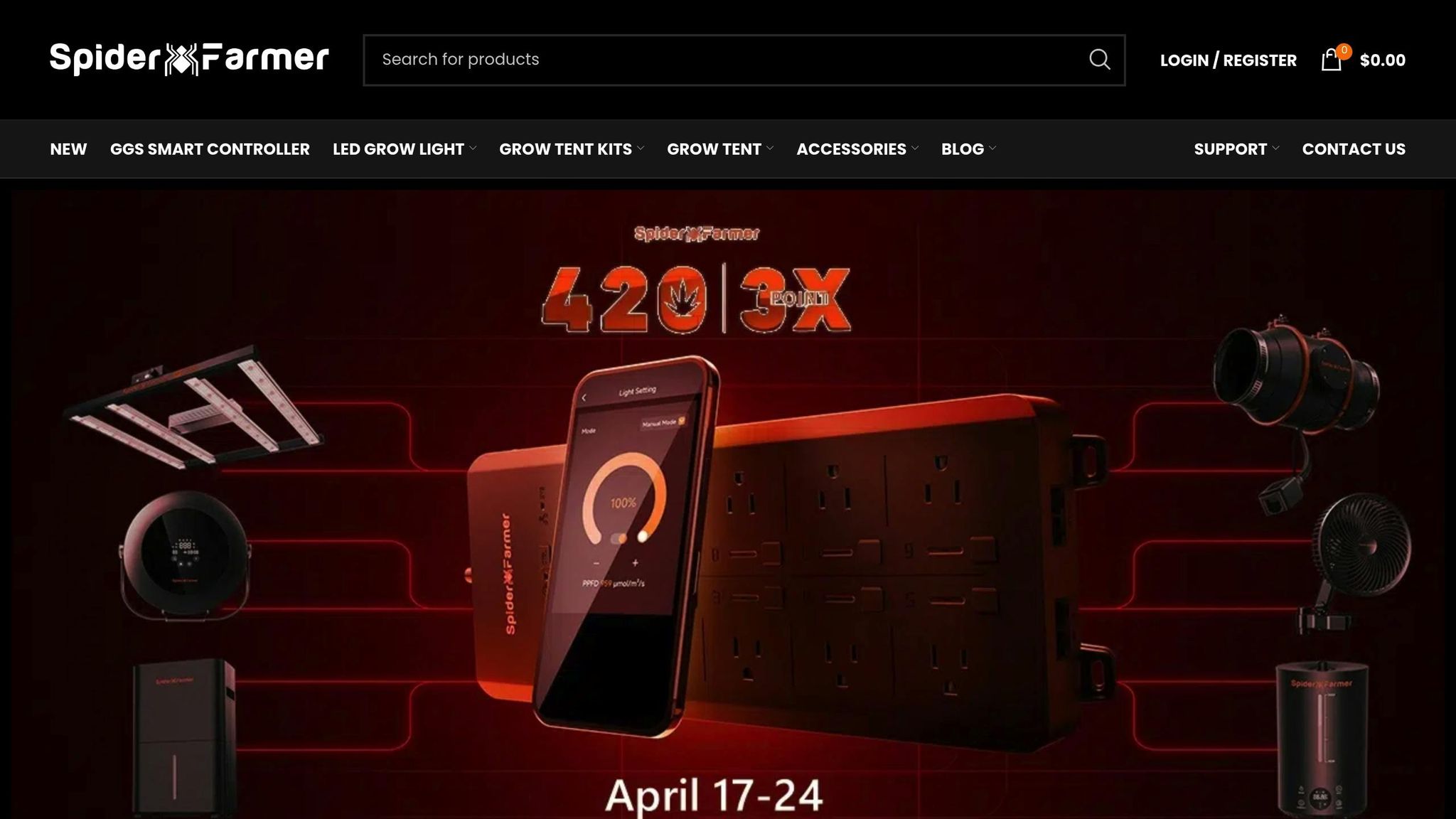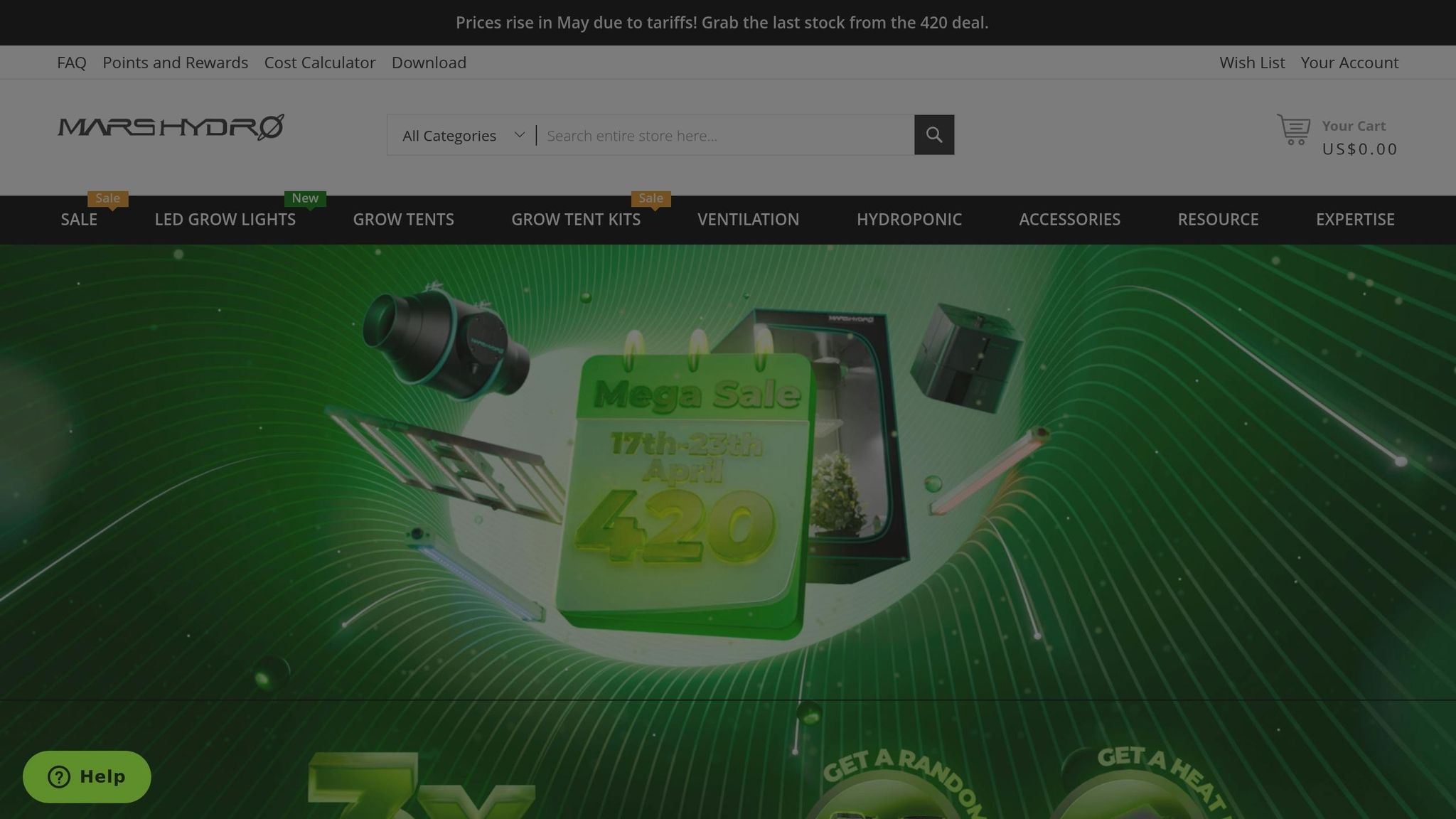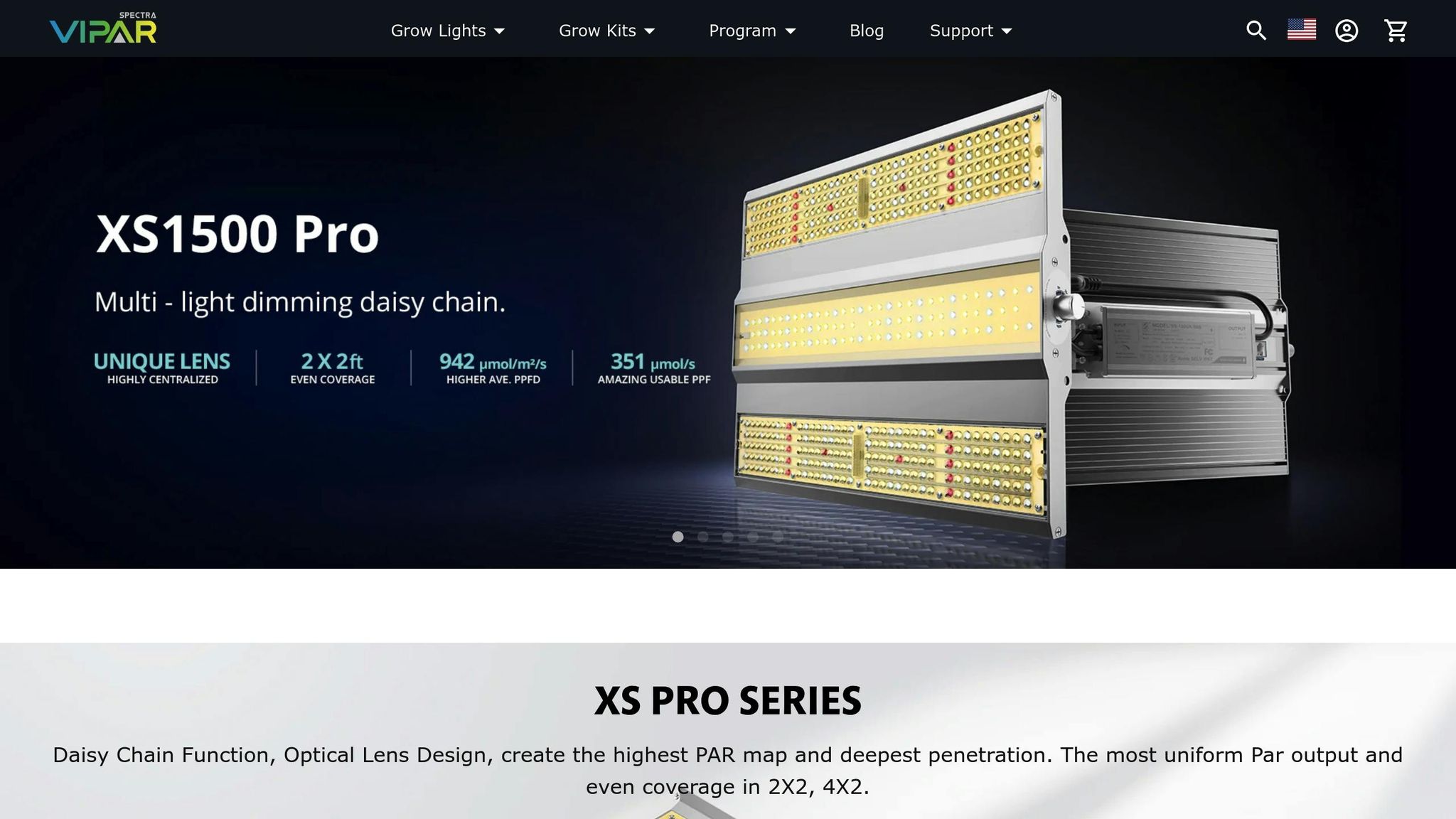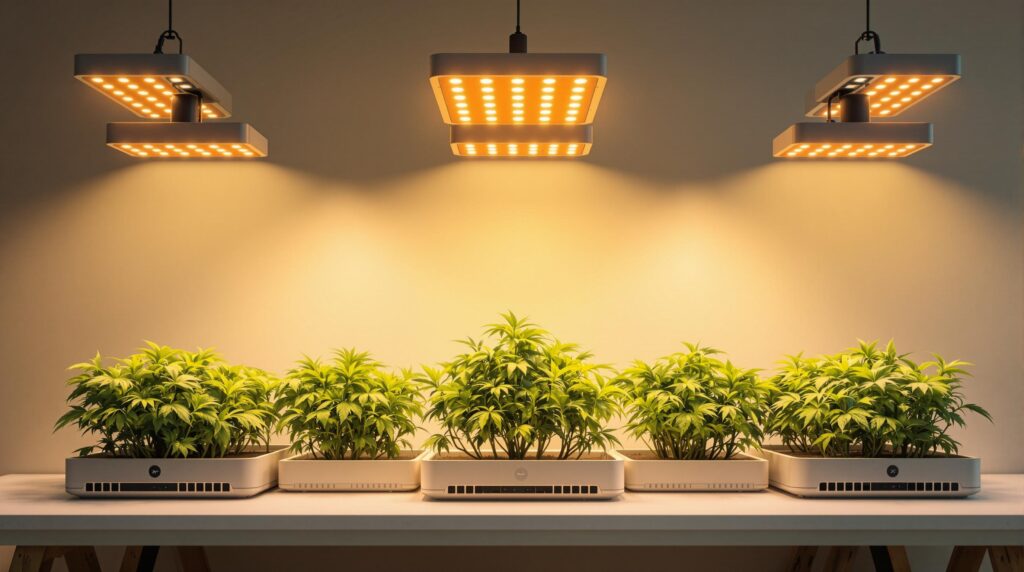LED grow lights are a game-changer for indoor cannabis cultivation. They’re energy-efficient, last up to 60,000 hours, and deliver full-spectrum light to support all growth stages. Whether you’re a beginner or a seasoned grower, choosing the right light can significantly improve your yields and plant health. Below are the top 5 LED grow lights and how they stack up:
Quick Overview:
- Spider Farmer SF-4000: Best for large setups (4’×4’–5’×5′), 450W, full-spectrum, $287.99, 5-year warranty.
- Mars Hydro TS 3000: Great for medium spaces (4’×4′), 420W, reflective hood for even light, $254.99, 5-year warranty.
- ViparSpectra XS4000: Affordable for medium setups, 400W, efficient cooling, $229.99, 3-year warranty.
- HLG 600 Rspec: High-performance (up to 600W), replaces 1,000W HID, $524.00, 5-year warranty.
- Phlizon FD6500: Budget-friendly for smaller spaces (3’×3′), 320W, $189.99, 2-year warranty.
Quick Comparison Table:
| Model | Coverage Area | Power | PPF (µmol/s) | PPE (µmol/J) | Price | Warranty |
|---|---|---|---|---|---|---|
| Spider Farmer SF-4000 | 4’×4’–5’×5′ | 450W | 1,413 | 3.14 | $287.99 | 5 years |
| Mars Hydro TS 3000 | 4’×4′ | 420W | 1,210 | 2.7 | $254.99 | 5 years |
| ViparSpectra XS4000 | 4’×4′ | 400W | 1,100 | 2.75 | $229.99 | 3 years |
| HLG 600 Rspec | 4’×4′ | 60–600W | 1,500 | 2.8 | $524.00 | 5 years |
| Phlizon FD6500 | 3’×3′ | 320W | 950 | 2.5 | $189.99 | 2 years |
Key Features to Consider:
- Coverage Area: Match the light’s footprint to your grow space.
- Spectrum: Choose full-spectrum LEDs for all growth stages.
- Efficiency: Look for high PPE (µmol/J) ratings to save energy.
- Heat Management: Opt for lights with effective cooling systems.
Ready to dive deeper? Keep reading for detailed reviews and tips to maximize your yields.
11 Best LED Grow Lights for 2025 | Ultimate 4’x4′ & 5’x5′ Guide
How to Choose LED Grow Lights
Before we dive into the top LED grow lights, it’s important to consider a few key factors to make the right choice for your setup.
Matching Coverage Area
Make sure the light’s coverage area matches your grow space dimensions. If the light is too small, plants near the edges won’t get enough light, which can affect their growth.
Key Factors to Consider
Here’s what to look for when selecting LED grow lights:
- Coverage: Measure your grow area to ensure the light provides even coverage.
- Spectrum: Opt for full-spectrum LEDs. Blue light (5,000–7,000K) is ideal for vegetative growth, while red light (3,500–4,500K) supports flowering.
- Efficiency: Check the umol/J rating to gauge efficiency. To estimate running costs, use this formula: watts × hours × your electricity rate.
- Heat Management: Look for lights with built-in fans or passive heatsinks to prevent overheating.
Coverage Footprint of Popular LED Models
| Light Model | Coverage Area |
|---|---|
| Spider Farmer SF-1000 (Small) | 2′ x 2′ |
| HLG 350R Quantum Board (Medium) | 2′ x 4′ or 3′ x 5′ |
| Spider Farmer SF-4000 (Large) | 4′ x 4′ or 5′ x 5′ |
With these factors in mind, let’s take a closer look at the top five LED grow lights.
1. Spider Farmer SF-4000 LED Grow Light

The Spider Farmer SF-4000 excels in key areas like coverage, spectrum, and efficiency. Featuring Samsung LM301H EVO diodes, this grow light delivers an impressive 3.14 µmol/J PPE, covers areas from 4′ × 4′ to 5′ × 5′, and uses 450 W ±5%. It replaces an 800 W MH/HPS system while using less energy. Its full-spectrum light (2800–3000 K, 4800–5000 K white; 660–665 nm red; 730–740 nm IR) is designed to support plants through all growth stages.
Key Specifications:
- Coverage: 4′ × 4’–5′ × 5′
- Power: 450 W ±5% (AC 100–277 V)
- Dimming Range: 0–100%
- Lifespan: 50,000 hours
- Weight: 14.06 lbs
Real-World Performance
Thanks to its fanless design, the SF-4000 operates silently at 0 dB, making it ideal for home setups. Built to last, it has earned a 4.6/5 rating from 7,008 Amazon reviews.
"Great LED’s, fantastic efficiency. Rugged as hell and has effortlessly trucked through humidity, gnats, dust, debris, storage, and shipping multiple times. Still runs like a champ over 3 years later."
– Chris, Amazon Customer
Investment and Value
Priced at $287.99 for the 4′ × 4′ version, the SF-4000 offers excellent value for serious growers. It includes a 5-year warranty, ensuring reliability over time. While some users have reported issues with the dimming knob, the unit’s overall performance remains strong. Its dimmable feature and compatibility with GGS controllers make it easy to adjust light intensity for different growth phases.
Check out the ‘LED Grow Light Specs at a Glance’ table below for a quick comparison, and don’t miss the Mars Hydro TS 3000 for another option.
2. Mars Hydro TS 3000 LED Grow Light

The Mars Hydro TS 3000 LED Grow Light delivers 420W of power through 1,016 chips, providing even light coverage for a 4’×4′ flowering canopy or a 5’×5′ vegetative area. Its specially designed reflective hood boosts light intensity and improves plant absorption.
This grow light offers a full-spectrum output (660-665 nm, 730-740 nm, 3000-3200K, and 6000-6500K) and key performance metrics: 420W ±5%, PPF 1,210 µmol/s, PPE 2.7 µmol/J, and a lifespan of 50,000 hours. It’s a great replacement for 600W HPS systems, using 25% less energy while potentially increasing yields by up to 30%, with an efficiency of 2.4 g/W.
Currently priced at $254.99 (down from $279.99), the TS 3000 includes dimming and daisy-chain functionality (supports up to 15 units), adjustable hangers, and operates on AC 100-277V. It’s backed by a five-year warranty and meets CE, ETL, RoHS, and UKCA certifications.
Next, we’ll look at the ViparSpectra XS4000, a strong choice for medium-sized grow tents.
3. ViparSpectra XS4000 LED Grow Light

Key Specifications:
- Coverage: 4’×4′ for flowering; 5’×5′ for vegetative growth
- Power: 400 W ±5% (AC 100–277 V)
- PPF/PPE: 1,100 µmol/s · 2.75 µmol/J
- Spectrum: 3,000 K white + 6,500 K + 660 nm red + 730 nm IR
- Dimming: Adjustable from 10% to 100%, supports daisy-chaining
- Cooling: Dual fans and aluminum heat sinks
- Lifespan: 50,000 hours
- Weight: 11.24 lbs
Performance Overview
The XS4000 provides consistent and even light distribution across the canopy, with an efficiency rating of 2.75 µmol/J. This makes it a dependable option for growers looking for quality results at a reasonable price. The dual fans and aluminum heat sinks keep the unit running smoothly, even during long grow cycles.
Pros and Cons
Pros:
- Priced affordably at $229.99
- Daisy-chain functionality for connecting multiple units
- Full-spectrum light tailored for cannabis growth
- Effective cooling system for stable performance
Cons:
- Warranty period of 3 years is shorter than some high-end options
- Fans can be a bit noisy in quieter setups
- Dimming knob could use better sensitivity
Next, compare these features with the HLG 600 Rspec below.
sbb-itb-c97b62c
4. Horticulture Lighting Group HLG 600 Rspec

Key Specifications:
- Power: 60-600 W, dimmable
- LEDs: Four quantum boards featuring Samsung LM301H and 660 nm deep-red LEDs
- Replacement: Designed to replace a 1,000 W HID system
- Price: $524 USD
Performance
The HLG 600 Rspec uses four custom quantum boards equipped with Samsung LM301H LEDs and deep-red 660 nm diodes. With adjustable power ranging from 60 to 600 W, it delivers consistent light coverage and surpasses the performance of a 1,000 W HID system in both yield and energy efficiency.
Light Distribution and Spectrum
This fixture is designed to evenly distribute light across the grow area, thanks to its four-board layout. The mix of white-spectrum and deep-red wavelengths supports strong foliage growth and helps produce denser, more robust flowers.
Pros and Cons
Pros:
- Adjustable power from 60 to 600 W for tailored light intensity
- Four-board design ensures uniform light coverage
Cons:
- Higher initial cost at $524 USD
- May need additional cooling or airflow when operating at full power
User Experience
A verified buyer shared that after switching to the HLG 600 Rspec, they noticed larger buds and a significant boost in trichome density, showcasing the light’s effectiveness.
Up next: the Phlizon FD6500, our budget-friendly finalist.
5. Phlizon FD6500 LED Grow Light

The Phlizon FD6500 is a budget-friendly option that offers the basics for small to medium grow setups.
Key Specifications:
- Coverage: 3’×3′ for flowering, 4’×4′ for vegetative growth
- Power: 320W ±5% (AC 100-277V)
- PPF/PPE: 950 µmol/s · 2.5 µmol/J
- Spectrum: 3000K white, 5000K blue, 660nm red, 730nm IR
- Dimming: Adjustable from 10% to 100%, daisy-chain compatible
- Cooling: Built-in heatsink with dual fans
- Lifespan: 50,000 hours
- Weight: 9.8 lbs
- Price: $189.99
- Warranty: 2 years
Performance Overview
The FD6500 is designed for compact grow areas, offering energy savings of about 40% compared to traditional 600W HPS systems. While its efficiency rating of 2.5 µmol/J isn’t on par with higher-end models, it still provides dependable performance for growers sticking to a budget. Its balanced light spectrum works well for both vegetative and flowering stages.
Pros and Cons
Pros:
- Affordable price for beginners
- Easy to set up and use
- Good heat management with fans and heatsink
Cons:
- Less efficient than premium options
- Shorter warranty compared to competitors
- Limited compatibility with advanced controllers
Check out the ‘LED Grow Light Specs at a Glance’ table below to see how the FD6500 compares to other models.
LED Grow Light Specs at a Glance
Here’s a quick comparison of our top five LED grow light picks to help you decide:
| Model | Coverage Area | Power Draw | PPF (µmol/s) | PPE (µmol/J) | Spectrum | Price | Warranty |
|---|---|---|---|---|---|---|---|
| Spider Farmer SF-4000 | 4’×4′ to 5’×5′ | 450W | 1,413 | 3.14 | 2800-5000K + 660-740nm | $287.99 | 5 years |
| Mars Hydro TS 3000 | 4’×4′ | 420W | 1,210 | 2.7 | 3000-6500K + 660-740nm | $254.99 | 5 years |
| ViparSpectra XS4000 | 4’×4′ | 400W | 1,100 | 2.75 | 3000-6500K + 660-730nm | $229.99 | 3 years |
| HLG 600 Rspec | 4’×4′ | 60-600W | 1,500 | 2.8 | White + 660nm | $524.00 | 5 years |
| Phlizon FD6500 | 3’×3′ | 320W | 950 | 2.5 | 3000-5000K + 660-730nm | $189.99 | 2 years |
This table highlights key details like coverage area, power consumption, light output, and warranty. Use it to pick a model that fits your indoor garden, budget, and performance needs.
Next, we’ll dive into how to maximize your yields using these LED grow lights.
How to Get Better Yields with LED Lights
Once you’ve selected one of our top LED models, you can use these tips to maximize your yields. Beyond the light itself, the way you manage your growing environment and daily practices can make all the difference.
Adjust Light Distance Correctly
Set the distance between your lights and plants based on wattage:
- Under 100W: 10–14 inches
- 100–300W: 14–24 inches
- 300–600W: 18–36 inches
- 600W+: 24–36 inches
Start with the maximum distance and gradually move the lights closer as your plants grow. Watch for signs of stress like leaf bleaching, yellowing, or brown spots. If you notice these, move the lights farther away immediately.
Use the Right Light Cycles
Cannabis plants thrive under specific light spectrums during different stages of growth. Blue light promotes compact, bushy growth during the vegetative stage, while red light enhances bud production in the flowering phase. Full-spectrum LEDs take the guesswork out by providing all the wavelengths your plants need.
Keep Your Lights Clean
A clean light fixture can increase output by up to 20%. To clean:
- Unplug the light.
- Use compressed air to remove dust.
- Wipe the surface with a microfiber cloth.
For tougher grime, use 99% isopropyl alcohol, but avoid this on silicone-coated LEDs.
Create the Ideal Environment
Ensure your plants thrive by maintaining:
- Reflective walls to distribute light evenly
- Stable temperatures
- Proper airflow
- Regular monitoring of humidity and pH levels
These steps help you make the most of your LED lights and create the best conditions for your plants to flourish.
Conclusion
With our top five recommendations and growing tips, choosing the right LED can help you achieve better yields, higher potency, and reduced energy costs. Keep these three key points in mind: maintain canopy temperatures between 80–84°F, select fixtures rated at least 1.5 µmol/J (PAR/PPFD), and opt for full-spectrum LEDs that include blue, red, and IR diodes.
"When it comes to light and cannabis, more is definitely NOT always better. So much of successful cultivation is about striking a perfect balance and striving towards harmony with growing inputs." – Herb CEO
Combining the right LED with steady temperatures, good airflow, and consistent upkeep creates the foundation for reliable, high-quality crops. By sticking to these basics, you’ll be ready to boost bud growth, trichome density, and terpene profiles.
FAQs
What should I look for when choosing the best LED grow light for my indoor cannabis setup?
When selecting an LED grow light for your indoor cannabis setup, focus on key factors like heat output, PAR (Photosynthetically Active Radiation) values, light coverage, programmability, and cost.
Heat output is crucial, especially in smaller spaces, as too much heat can stress your plants. PAR values indicate how effectively the light supports photosynthesis – higher values generally mean better plant growth. Ensure the light’s shape and coverage area match your grow space, and consider how many lights you’ll need to meet your plants’ requirements. Programmable features, such as timers and dimmers, can make managing your grow setup easier. Finally, choose a light that fits your budget without compromising on quality or performance.
By considering these factors, you’ll be better equipped to select an LED grow light that maximizes your cannabis yield and quality indoors.
What are the best ways to boost cannabis growth and yields using LED grow lights?
To enhance cannabis growth and maximize yields with LED grow lights, start by choosing full-spectrum LED lights. These lights simulate natural sunlight, providing the essential wavelengths your plants need for every stage of growth, from seedling to flowering.
LED grow lights are highly energy-efficient, produce minimal heat, and are environmentally friendly. This not only reduces energy costs but also lowers the risk of heat stress on your plants, leading to healthier growth and higher-quality buds. Position your lights at the recommended distance from the canopy to ensure optimal light penetration without causing light burn. Regularly adjust the height as your plants grow to maintain efficiency.
How can I maintain my LED grow lights to ensure they last and perform well?
To keep your LED grow lights performing at their best, regular maintenance is key. After each harvest, clean the lights using a non-abrasive cloth and isopropyl alcohol to remove dust and buildup that can reduce light output. For glass covers, a gentle glass cleaner works well. Always unplug the lights before cleaning to ensure safety.
Inspect your lights periodically for any signs of wear or damage. Replace bulbs or components if light output decreases significantly, typically every 9–12 months, depending on usage and the manufacturer’s recommendations. Using a light meter can help monitor output and ensure your plants are receiving the optimal amount of light.
